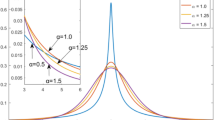Abstract
The MUltiple SIgnal Classification (MUSIC) estimator has been widely studied for a long time for its high resolution capabilities in the domain of the directional of arrival (DOA) estimation, with the sources assumed to be point. However, when the actual sources are spatially distributed with angular dispersion, the performance of the conventional MUSIC is degraded. This paper deals with the sensitivity of MUSIC to modeling error due to coherently distributed (CD) sources. A performance analysis of an extended MUSIC taking into account a generalized steering vector based on a CD source model (CD-MUSIC) is first studied. We establish closed-form expressions of the DOA estimation bias and mean square error due to both the model error and the effects of a finite number of snapshots. The aim of this paper is also to determine when the point source assumption is acceptable for standard MUSIC. The analytical results are validated by numerical simulations and discussed in different configurations.






Similar content being viewed by others
References
Ciuonzo, D., Romano, G., Solimene, R.: Performance analysis of time-reversal MUSIC. IEEE Trans. Signal Process. 63(10), 2650–2662 (2015)
Ma, G., Sha, Z., Liu, Z., Huang, Z.: Ica-based direction-of-arrival estimation of uncorrelated and coherent signals with uniform linear array. Signal Image Video Process. 8(3), 543–548 (2014)
Liu, C., Liu, F., Zhang, S.: A novel direction-of-arrival estimation method for wideband signals. Signal Image Video Process. 6(1), 141–145 (2012)
Tao, J.W., Chang, W.X., Cui, W.: Direction-finding of coherent signals based on cylindrical vector-hydrophones array. Signal Image Video Process. 4(2), 221–232 (2010)
El Markhi, H., Haibala, M.M.O., Mrabti, F., Chargé, P., Zouak, M.: An improved cyclic beamforming method for signal doa estimation. Signal Image Video Process. 1(3), 267–272 (2007)
Chu, Ning, Mohammad Djafari, Ali, Picheral, José: Robust Bayesian super-resolution approach via sparsity enforcing a priori for near-field aeroacoustic source imaging. J. Sound Vib. 332(18), 4369–4389 (2013)
Brooks, T.F., Humphreys, W.M.: A deconvolution approach for the mapping of acoustic source (DAMAS) determined from phased microphone arrays. J. Sound Vib. 294, 856–876 (2006)
Birot, G., Albera, L., Wendling, F., Merlet, I.: Localisation of extended brain sources from EEG/ MEG: the Ex So- MUSIC approach. Neuroimage 56(1), 102–113 (2011). (Elsiever)
Young, A.P., Guza, R.T., Adams, P.N., O’Reilly, W.C., Flick, R.E.: Cross-shore decay of cliff top ground motions driven by local ocean swell and infragravity waves. J. Geophys. Res. Oceans (1978–2012), 117(C6), 50–60 (2012)
Pedersen, K.I., Mogensen, P.E., Fleury, B.H.: A stochastic model of the temporal and azimuthal dispersion seen at the base station in outdoor propagation environments. IEEE Trans. Veh. Technol. 49(2), 437–447 (2000)
Besson, O., Stoica, P.: Decoupled estimation of DOA and angular spread of a spatially distributed source. IEEE Trans. Signal Process. 48(7), 1872–1882 (2000)
Zoubir, A., Wang, Y., Chargé, P.: Efficient subspace-based estimator for localization of multiple incoherently distributed sources. IEEE Trans. Signal Process. 56(2), 532–542 (2008)
Hu, A., Lv, T., Gao, H., Zang, Z., Yang, S.: An ESPRIT-based approach for 2-d localization of incoherently distibuted sources in massive MIMO systems. IEEE J. Sel. Top. Signal process. 8(5), 996–1011 (2014)
Valaee, S., Champagne, B., Kabal, P.: Parametric localization of distributed sources. IEEE Trans. Signal Process. 43(9), 2144–2153 (1995)
Raich, Raviv, Goldberg, Jason, Messer, Hagit: Bearing estimation for a distributed source: modeling, inherent accuracy limitations and algorithms. IEEE Trans. Signal Process. 48(2), 429–441 (2000)
Xiong, W., Picheral, J., Marcos, S.: Performance analysis of MUSIC in the presence of modeling errors due to the spatial distributions of sources. In: Acoustics, Speech and Signal Processing (ICASSP), 2015 IEEE International Conference on, pp. 2804–2808. IEEE (2015)
Trump, T., Ottersten, B.: Estimation of nominal direction of arrival and angular spread using an array of sensors. Signal Process. 50(12), 57–69 (1996)
Lee, J., Song, I., Kwon, H., Lee, S.: Low-complexity estimation of 2 D DOA for coherently distributed sources. Signal Process. 83(8), 1789–1802 (2003)
Raich, R., Goldberg, J., Messer, H.: Bearing estimation for a distributed source via the conventional beamformer. In: Statistical Signal and Array Processing, 1998. Proceedings., Ninth IEEE SP Workshop on, pp. 5–8. IEEE (1998)
Astély, D., Ottersten, B.: The effects of local scattering on direction of arrival estimation with MUSIC. IEEE Trans. Signal Process. 47(12), 3220–3234 (1999)
Swindlehurst, A., Kailath, T.: A performance analysis of subspace method in the presence of model errors : case of MUSIC. IEEE Trans. Signal Process. 40(7), 1758–1773 (1992)
Kangas, A., Stoica, P., Soderstrom, T.: Finite sample and modeling error effects on ESPRIT and MUSIC diretion estimators. IEE Proc Radar Sonar Navig. 141(5), 249–255 (1994)
Weiss, A.J., Friedlander, B.: Effects of modeling errors on the resolution threshold of the MUSIC algorithm. IEEE Trans. Signal Process. 42(6), 1519–1526 (1994)
Tague, J.A., Caldwell, C.I.: Expectations of useful complex wishart forms. Multidimens. Syst. Signal Process. 5(3), 263–279 (1994)
Author information
Authors and Affiliations
Corresponding author
Appendix A
Appendix A
Based on (9), we study the case that the number of snapshots N is big enough, so that \({\varDelta }\hat{\mathbf{R }}, B_2, C_2\) is small, we can make the approximation :
Introducing (23) in (9), and keeping only first-order terms in \({\varDelta }\hat{\mathbf{R }}\), the expression of DOA estimation error can be given by:
\({\varDelta }\hat{\mathbf{R }}\) is a Wishart distribution [24] matrix with the property \(E[{\varDelta }\hat{\mathbf{R }}] = 0\), so that \(E[B_2] = E[C_2] = 0\). It follows that the DOA estimation bias can be derived as (10). Similarly, the DOA estimation MSE can be given by:
Using the same method in [21], we obtain \( E[B_2^2] = \frac{\sigma ^2_b}{2N}\varphi \) and \(E[B_2C_2] = \frac{\sigma ^2_b}{2N}\chi \), where:
Rights and permissions
About this article
Cite this article
Xiong, W., Picheral, J. & Marcos, S. Robustness of the coherently distributed MUSIC algorithm to the imperfect knowledge of the spatial distribution of the sources. SIViP 11, 721–728 (2017). https://doi.org/10.1007/s11760-016-1015-1
Received:
Revised:
Accepted:
Published:
Issue Date:
DOI: https://doi.org/10.1007/s11760-016-1015-1




